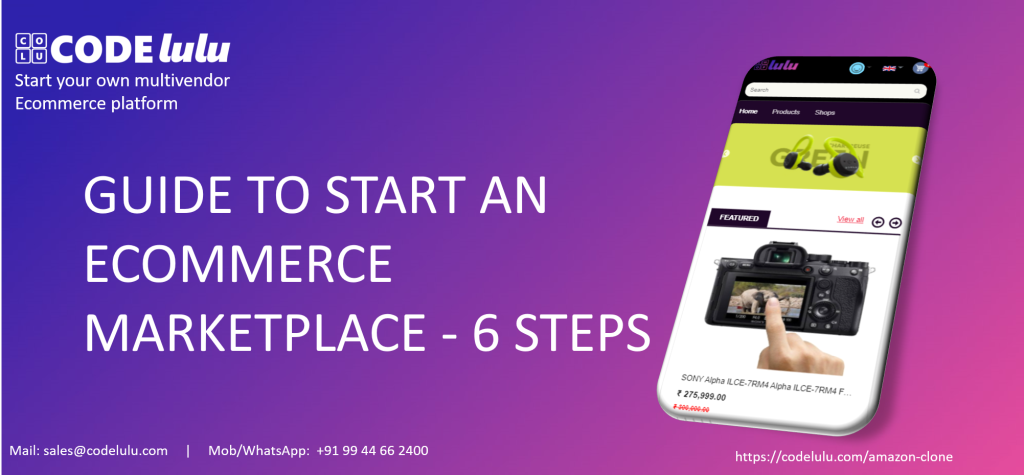
It’s the ideal time to launch and expand an ecommerce marketplace. E-commerce is expected to increase rapidly in the future, according to predictions by global organisations. For example, GroupM predicts that by 2024, the industry would account for 25% of all retail sales. Because of the numerous sellers, online marketplace startups mostly contribute to this expansion. It’s simple to set up your own online marketplace platform. It does not necessitate any coding expertise. However, some coding knowledge is preferred. However, following six simple steps will walk you through the process of launching an online marketplace.
- Make a domain plan.
- Choose a platform for your e-commerce marketplace.
- Choose a payment method.
- Decide on your products and how much of them you’ll need.
- Begin optimising and publicising your marketplace.
- Begin tracking your market performance.
Multivendor marketplace functionalities are completely integrated by online store platform suppliers such as Magento and Shopify. It does not necessitate a large financial investment. Furthermore, you will obtain greater results from this integration than you would from a single-vendor online store.
The combination of marketplace solutions with online store software made it easier to set up an online marketplace. Every entrepreneur is inspired to establish online marketplace firms that are constantly growing as a result of this mingling.
We’ve done extensive research on a variety of markets. We learned about the difficulties and roadblocks they encountered. What hurdles did they face that ultimately led to their success? All of those experiences are covered in this tutorial, making it simple for you to create a marketplace platform.
In six easy steps, you can start your own online marketplace.
Continue reading if you’re in the same boat. This step-by-step guide on starting an online marketplace will help you through the process. To develop a successful marketplace, you must follow these steps.
Step 1: Prior to starting an ecommerce marketplace, plan your domain.
Before you establish your own online marketplace, you should first get a domain name. This section does not bother you too much. You may create an excellent domain name in a few simple steps. Your marketplace will be ready for sales volume with such a domain name.
But, what would be a good place for you to start? What kind of arrangements would you suggest? This is what we’ll look at in this section. Continue reading to learn how to fix your internet business’s IT stack.
Your domain’s hosting
You may have popped up with your marketplace name until now. Maybe you’ve figured out your image and space name. If that’s the case, you can keep enrolling in your current location.
Whatever the case may be. If you can’t think of an idea or a name, or if you’re having trouble finding your name, read the following advice:
- Choose a name that reflects the nature of your online marketplace firm.
- People should be able to figure out who you are based on your market name.
- Multi-vendor marketplaces identify themselves as XYZ retailers.
- Your online marketplace startup’s main message is conveyed via the name.
Register your domain name
After you’ve decided on a domain name, you’ll need to register it with a recognised space enlisting centre. The following are a few of the most important:
- Nexcess
- Cloudways
- AWS
You’ll have to pay to register your marketplace name. The cost will be determined by the name you choose. Every now and then, name enlistment centres will hold promotions. As a result, you may need to shop around for the best domain for your business.
Step 2: Decide on a platform for your e-commerce business
The next step is to pick an e-commerce platform. This is the foundation of your new online marketplace. Your marketplace’s software enables it to provide vital services to you, your suppliers, and your shoppers.
Robust software systems make it simple to create a marketplace. It improves the efficiency of your marketplace’s operations. Your online marketplace startup takes care of some of the following tasks with ease:
- Multiple transactions are supported.
- There are no limits to the number of products listed.
- Provide prompt client service.
- Maintain control over vendors and their orders.
- To promote your marketplace, you’ll need marketing tools.
- Vendor-uploaded products are automatically approved.
- Analyze the growth of your marketplace’s vendors.
To create a marketplace, leading software solutions such as Magento, Prestashop, and Opencart are available.
However, it is dependent on which of the two types of platforms you select. If you want a lot of customization, go with open-source, or go with SAAS if you’re short on cash and resources. Yes, there are two types of e-commerce platforms: open-source and SAAS.
Open-source
You may host, update, and upgrade your marketplace using an open-source online marketplace platform. Open-source software allows you to run your new online marketplace enterprise with a deep understanding of coding and web-based business.
Adaptability is a notable aspect of open-source ecommerce marketplace software. It responds effectively to any changes you make. This flexibility feature allows you greater control over how your marketplace looks, feels, and operates.
However, using an open-source platform means you’ll have to code every aspect of your marketplace. Starting an ecommerce marketplace with open-source coding software takes several weeks. You write codes for every part of it. Image processing, server logging and monitoring, emails, and much more are just a few of the services available. This requires both time and money.
You can also hire specialists, such as the Cedcommerce team, if you like. They make all of the above-mentioned difficult aspects of launching an ecommerce marketplace on an open-source platform much easier.
SAAS
Marketplace systems that provide software as a service (SAAS) provide you with a ready-made marketplace. On this platform, you don’t have to code every part of your marketplace. You simply pay a monthly subscription cost. This cost includes all of the features you’ll need in a marketplace, including security.
The most important technical component of your store is your e-commerce marketplace platform. To avoid seeming sentimental, your online marketplace agreement could be the decisive factor in your company’s success. So take advantage of the opportunity to learn about, vet, and choose your stage.
Step 3: Choose a payment gateway
Payment mechanisms are important covering in this online marketplace guide for obvious reasons. As a result, payment is a critical component of your multi-vendor ecommerce operation. This is why, before launching an online marketplace, you should familiarise yourself with payment systems. Make sure you pick the right payment gateway and that it works well with your marketplace.
A payment gateway, for the uninitiated, is a web-based processing facility that approves and sets up card payment transactions. Payment channels essentially allow you to accept MasterCards on your website.
There are a few payment options on the market, and a few of the most important are:
- Stripe
- PayPal
- 2Checkout
- WorldPay
Consider the following important factors when choosing these payment gateways, as they will determine whether or not buyers choose to pay through one of them on your marketplace platform:
Expenses and Fees
Payment providers are responsible for all costs associated with providing payment services on your marketplace. To cover these costs, they charge a set amount. Many of them may have set costs for each exchange. Others, on the other hand, have variable rates or fees. The best decision will be based on your budget and the various options available to you.
Fees for setup, chargebacks, and other types of payments may also apply. A monthly fee and other administrative costs may be charged by payment providers.
Your location, as well as the location of your clients, may play a role. As some entryways aren’t bothersome to another country. Many entryways, on the other hand, levy surcharges when payments are made from outside the United States.
Types of payments
Another massive thought? The different types of payments you’ll have to accept as you build a marketplace. Almost all payment portals accept card payments, but if you want to accept non-traditional forms of payment, such as digital currencies like Bitcoin, you’ll need to get creative. If that’s the case, you’ll want to double-check that the gateway supports that payment method.
You can integrate the following payment methods:
Another massive thought? The different types of payments you’ll have to accept. Almost all payment portals accept card payments, but if you want to accept non-traditional forms of payment, such as digital currencies like Bitcoin, you’ll need to get creative. If that’s the case, you’ll want to double-check that the gateway supports that payment method.
- Payments with a prepaid card
- E-wallets
- Cryptocurrencies
- Transfers between banks
- Cash
- Payments via mobile device
Payment integration solutions for e-commerce marketplaces
Payment integration solutions make managing your online marketplace much easier. They combine various payment methods to give you the push you need to start your own online marketplace. Such options help you save both time and money. Furthermore, buyers do not make multiple purchases on different websites. As a result, payment integration solutions help customers have a better checkout experience.
Step 4: Choose your products and how much of them you’ll need.
Any e-commerce marketplace’s lifeblood is its products. As a result, you should gather vendors for it. You’ve figured it out!! We’ll talk about how to decide what to sell, which vendors you’ll need, and how to get their attention to your marketplace in this section.
Looking for suppliers
It’s critical to investigate your vendors while attracting sellers. Find out what they anticipate from your marketplace. Many of them are familiar with the services offered by Amazon, Flipkart, and eBay. As a result, they search your online marketplace for similar or better options.
This crucial research helps you shape your market to meet their needs.
Give them a reason to think your online marketplace startup will outperform the competition. It could be for a variety of reasons, such as ensuring a smooth transaction or providing shipping services. They have inventory management systems that are simple to use. As soon as you start your own online marketplace, you must earn their trust by paying them on time.
Communicate with your vendors
Pay a visit, make a decision, or send an email to potential vendors to get a better understanding of them.This will not only help you gather a lot of data and get your questions answered, but it will also allow you to judge the semantics of each supplier. This is crucial, especially if you’re dealing with international suppliers.
The result of not following this procedure is that you will miscommunicate or end up with incorrect merchandise or orders.
Persuade your suppliers
Convincing vendors presents its own set of difficulties. However, ensuring their company’s profit from your marketplace will compel them to join. As a result, keep your marketplace’s ability to generate benefits for them in mind. They should not, on the other hand, regret signing up later. Persuade your vendors that your online marketplace provides them with the best services
- They can run their business with the help of your online marketplace.
- It is able to register them for a low fee. They don’t need to put a lot of money into it.
- They can keep track of their sales with the vendor management system.
- If the market analysis report shows slow growth, they can devise strategies to increase sales.
- Your marketplace makes it easier for them to sell their stale goods.
- You set up a solid inventory management system for them.
Step 5: Processes for order fulfilment
If your marketplace does not provide convenient delivery options, buyers will leave. When shopping carts become inconvenient, they abandon them. Instead, they are confronted with issues such as:
- Delivery costs are extremely high.
- Slow delivery speed
- Cumbersome return policies
- Long checkout processes
All these reasons stem from the fact that buyers do not want to waste their time on your marketplace. Therefore, they expect free and fast shipping from it. It remains the leading driver of repeated sales. 95 percent of buyers look for fast delivery options while shopping online.
But vendors feel the pain to offer free shipping. Most of them pay a third of their profit on shipping for their businesses. That’s why they levy heavy shipping fees on buyers. In this way, they lose leads. That’s where your online marketplace platform comes to the rescue.
How you can play big in this order fulfilment field? Read here:
Shipping elements you need
Shipping carriers & couriers
Connecting shipping operators to your marketplace. Some of the right operators are UPS, DHL, and FedEx.
Order management
Order management systems that process orders. It tracks orders with the help of CRM software like Salesforce and Hubspot.
Fulfillment
The packaging, labelling, and shipping of items after receiving orders.
Tracking
A tracking system that updates status such as shipped or in-transit.
Returns
A smooth returns process promotes loyal customers.
Customer service
Form a team to provide customer support.
The cost of fulfilling orders
Buyers pay on your marketplace for products, delivery, and shipping. They also additionally pay taxes such as VAT. You apply shipping costs on them for different variables. Those variables include dimensions, weight, or carrier.
As far as delivery, you charge buyers for its own variables. Those variables include handling, packaging, and insurance.
Marketplace shipping integrations
How do you connect your marketplace to a shipping solution? There are third-party platforms like Cedcommerce. Cedcommerce provides shipping APIs to connect shipping companies to your marketplace. It connects companies such as Fedex or UPS. The marketplace integrations prevent errors, integrate multiple carrier options, and validate addresses.
Step 6- Optimize and spread the name of your marketplace
Along these lines, you set up your payment portal, shipping services and other facilities. You now finally build a marketplace. But how will people know about it? Let’s find out
Search Engine Optimization (SEO)
Starting an ecommerce marketplace involves driving folks from all around the internet. When you start an ecommerce marketplace, it’s intrinsic to make yourself be found. All this gameplay revolves around the mastermind “SEO.” The foremost necessary factor for search engine optimization is backlinks. The backlinks you provide your domain generate a tally of 100 known as your Domain Rank.
The domain rank determines where you are available on the Google search results over specific keywords and the way you retrieve a lot of organic traffic you get to your website. But to induce backlinks and rank extreme on Google, you ought to subscribe to the simple backlink building.
Email marketing
Email Marketing is an extremely effective strategy for emails to prospects and customers. Effective promoting emails convert prospects into customers and switch one-time patrons into customer loyalty, raving buyers making you capable to acquire leads and generate sales, 24/7.
People who purchase merchandise marketed through email pay more as compared to people who don’t receive email offers. In fact, email selling has major ROI and that’s huge! And if you’re curious, social media converts even higher.
Think Again: The common price of an email is a minimum by thrice over that of social media.
Advertisements
Next up when you have been victorious in achieving tonnes of programme clicks with SEO, search engine advertisements could be a vital medium to drive additional traffic from Google search queries to your website.
The 3 varieties of campaigns you’ll run with Google Ads are Search, Display, and Responsive. You need to check before you start your own online marketplace which of them works and optimise ad campaigns too.
We conjointly advise running internet retargeting ads aboard these varieties of paid traffic funnels.
Social Media
After you build a marketplace, social media platforms should adequately attract the eye of purchasers. Their social media approach could be entirely disparate from the one you could be practising. Take another examination of the best user’s profile created earlier on your favourite social media.
It’ll provide you valuable insight into your target market audience and will receive new data. Identify wherever they pay time and what prompts them to create purchases.
It’ll facilitate you pinpoint the social media channels that are vital to the present target market. Knowing this data will facilitate your device an additional, economic social media promoting strategy utilising these passages.




